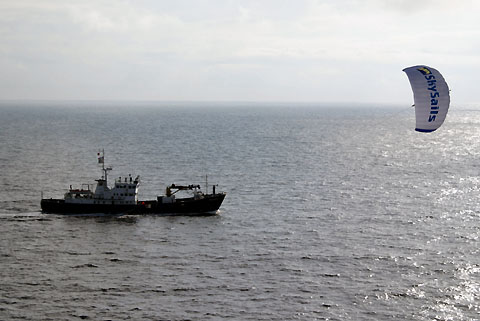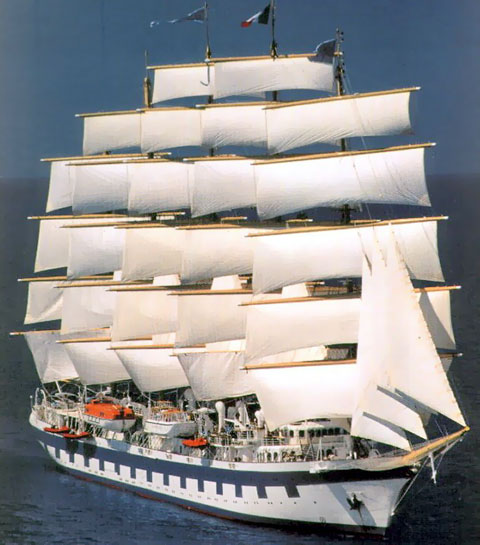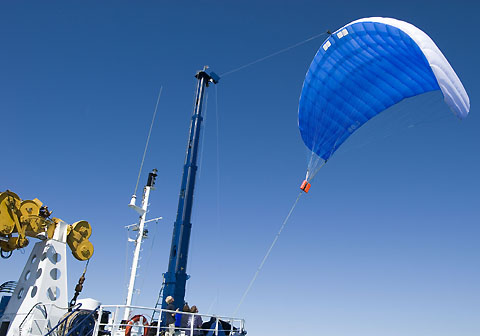Covered in the December 2007 Utne Reader & www.skysails.info
Hamburg
based SkySails uses a combination of conventional engines and giant,
computer-maneuvered kites to power ships. With kites ranging in size
from 160 to 5,000 square meters, the systems can cost a few million
dollars to install.
By
the use of a SkySails-System fuel costs can be lowered between 10-35%
on annual average depending on actual wind conditions and achievable
operational period. Under optimal wind conditions, fuel consumptions
can temporarily be reduced up to 50%. Thus large amounts of expensive
oil can be saved and the burden on declining oil reserves is reduced
(see development of the oil price).
According to
an up-to-date study from the University of Delaware (USA), the world
trade fleet consumes approx. 280 million tons of oil or 2 times more
than Germany (approx. 125 million tons) (see resources).
Since cargo ships run on extremely sulphurous fuel oil, their emissions
damage our environment considerably (see toxicity).
Experts from Lloyd’s Register Quality Assurance (London) estimate that
shipping traffic generates 7% of the total worldwide output of sulphur
dioxide (SOx), and is thus one of the main causes of climate-damaging
gases (see climatic impact). Through the consistent global use of the
SkySails technology worldwide, it would be possible to cut over 146
million tons of CO2, which equals approx. 15% of the CO2 emissions of
Germany.
In accordance with new regulations from the “International Maritime
Organization” (IMO) ship owners will, in future, have to significantly
reduce the toxic emissions of their ships. (see statutory provisions).
Development of the oil price
Since the fossil energy resources on our planet are limited, the prices
of these resources are rising continuously. During 2005, numerous
resource prices reached an all-time peak due to high demand (report
"World Commodity Prices 2005 to mid-2007" of the resource working party
of the AIECE (“Association d’Instituts Européens de Con-joncture
Économique“ or “Association of European Conjuncture Institutes“). At
the beginning of September 2005 the oil price reached an all-time high
of 67 US dollars per barrel for Brent oil and over 70 US dollars for
the WTI price (West Texas Intermediate = crude oil quality for pricing).
Current prognoses are for a continuing significant increase in oil
prices: The high growth of demand can not be covered even by increasing
output or opening up new oil resources. This is the conclusion of the
study “strategy 2030 - energy resources” carried out jointly by the
Hamburg-based Berenberg Bank and the Hamburg-based
Welt-Wirtschafts-Institut (HWWI) (world economic institute). With
regard to the development of energy resources markets, director Prof.
Dr. Thomas Straubhaar from HWWI notes: “With a predicted annual average
growth of the world economy of 2.8% for the period, the oil price,
starting at just under 40 US-Dollars per barrel in 2004, could rise to
120 US Dollars by 2030.”
High oil prices considerably increase a ship's operating costs. Fuel
costs already amount to more than half of the operating costs of a
ship. Ship owners often deploy special “Fuel-Saving-Groups” to reduce
fuel consumption in ship new builds.
Increasing efficiency using ship diesel has almost reached its maximum
potential and is also extremely expensive. According to the calculation
of an expert on ship propulsions, shipping companies would have to
invest up to 500,000 Euros in order to reduce a ship’s fuel consumption
by 1%. Fuel savings of 5% would be a fantastic performance for ship
owners, according to Niels Stolberg, managing partner of Bremen-based
shipping company Beluga Shipping GmbH.
Resources
Increasing economic globalisation and the concomitantly increased
exchange of goods, has brought high growth rates in shipping, which
have continuously outstripped the growth rates of the world economy.
Thus, the capacity of the world trade fleet rose by 5.7% in 2005, while
the global economy grew by just 3.1%. In 2002 experts of the WGBU
(Wissenschaftlicher Beirat der Bundesregierung Globale
Umweltveränderungen) (scientific advisory board of the German federal
government on global environmental changes) predicted average growth
rates of 1-4% for the coming years. According to the WGBU's data, the
entire world trade fleet in 2001 consisted of approx. 41,000 cargo and
passenger vessels (over 300 RT), within which were 10,000 tankers,
6,000 ships for dry bulk articles, 2,600 container ships, 18,000
general cargo and roll-on-roll-off-freighters, 2,500 combined
cargo-passenger ships and ferries, as well as 1,500 passenger ships.
According to “Lloyd’s Register” a total of approx. 90,000 civil ships
with over 100 gross register tons cross the oceans.
According to an up-to-date study from the University of Delaware (USA),
the world trade fleet consumes approx. 280 million tons of oil or 2
times more than Germany (approx. 125 million tons) (see resources).
Toxicity
The biggest environmental problem is that 90% of ship diesels (the
standard propulsion for medium to large tankers, bulk barrier and
container ships are slowly-operating two-stroke diesel engines) run on
a comparatively cheap, but highly contaminated fuel oil. The low-grade
fuel oil is a viscous substance, which is a by-product residual at the
end of crude oil production. It consists of all the components of crude
oil unusable for the production of petrol or diesel fuel.
Fuel oil with low sulphur
levels (MDO/MGO quality) costs almost twice as much as the IFO 180 and
IFO 380 qualities predominantly in use.
During the combustion of fuel oil large quantities of toxic substances
pass into the air. In comparison to other substances fuel oil has
characteristics causing considerable environmental pollution. Fuel oil
contains up to 5% sulphur depending on its origin. Low sulphur levels
have to be calculated at a cost of a minimum of 20 (currently approx.
50) Euros per ton and percent (according to the ISL (Institute for
maritime traffic economy and logistics) 2001; from: special survey 2002
WGBU (Scientific advisory board of the federal government global
environmental changes)).
The combustion of fuel oil mainly produces nitric oxides (NOx). A
90-95% reduction of NOx emissions through, for example, the
installation of ship catalysts, requires the investment of approx.
40,000 Euros per Megawatt (MW) installed propulsion power.
Additionally, costs for operating supplies and increased fuel
consumption have to be covered.
Nitric oxides (NOx) react with hydrocarbons (HC) under the influence of
sunlight, generating ozone and leading to smog. Sulphur oxides can
aggravate respiratory illnesses and are a cause of “acid rain”. Ozone
leads to breathing difficulties in humans and damages flora.

image above: ship under way with towing assist from SkySail
Climatic Impact
Cargo shipping is one of the main causes of climate-damaging emissions
and thus contributes substantially to environmental pollution.
According to a study from the University of Delaware (11/2003), cargo
shipping emits the same amount of nitric oxides as the entire USA.
Additionally, according to investigations by the German journal “Bild
der Wissenschaft 1/2006”, commercial shipping is the 3rd largest source
of climate-effecting toxic substances after industry and road traffic.
Experts from
Lloyd’s Register Quality Assurance (London) estimate that, with an
annual output of 10 million tons, shipping traffic generates 7% of the
total global output of sulphur dioxide (SOx).
A special survey of the WGBU (2002) reaches a similar conclusion:
global shipping traffic is responsible for approx. 7% of the CO2
emissions of the traffic sector, or for approx. 2% of global CO2
emissions. Furthermore shipping accounts for approx. 7% of all SO2 and
11-12% of all NOx emissions.
According to current calculations by scientists from the Hamburg-based
Max-Planck-Institute for Meteorology (Prof. Hartmut Graßl, 11/2005)
climate will change more quickly than ever before in the coming
century. This is the conclusion of the latest climate model
calculations of various scenarios up to 2100. Global warming, resulting
from climate change, is already noticeable worldwide in the form of
extreme weather, such as Hurricane Katrina in the USA. Expert opinion
predicts that such extreme weather occurrences, including those
involving heat aridity and precipitation, will become more frequent and
more extreme in the future.
Greenhouse gas concentrations are presently higher than they have been
at any point in the last 650,000 years. This is the opinion of a
European research team in collaboration with scientists from the
Alfred-Wegner-Institute of Polar and Maritime research. Prof. Dr.
Thomas Stocker from the Physical Institute of the University of Bern
substantiates this fact: “Analysis shows that, at 0.38 parts per
thousand by volume, today's level of atmospheric hydrocarbon is 27%
percent higher than the highest level measured during the last 650.000
years.”
Dr. Veronica Eyring from the Institute of Physics of the Atmosphere
(Deutsches Zentrum für Luft- und Raumfahrt e.V.) (German Centre for
Aerospace) notes the following global toxic emissions of the shipping
industry in 2002:
CO2: 813 million tons per year (in 2001)
NOx: 21.4 million tons per year (in 2001)
SO2: 12.0 million tons per year (in 2000)
Statutory provisions
Substantial cost pressure will arise for ship owners in future due to
the introduction of emission-dependent charges in cargo shipping.
The ‘International Maritime Organisation’ (IMO), a sub-organisation of
the UN, is responsible for ship safety and the prevention of pollution
caused by ships at an international level. In order to reduce air
pollution caused by ships the IMO enacted laws on 19th May 2005 (MARPOL
73/78, Annex VI) regulating threshold values for the emission of SOx
and NOx and controlling the emission of ozone-reducing substances by
ships. These laws include the stipulation of a maximum sulphur level of
4.5% in heavy oil internationally, and a maximum sulphur level of 1.5%
in ‘SOx Emission Control Areas’. The English Channel is a SOx Emission
Control Area, as the Baltic Sea will be from the beginning of 2006, and
the North Sea from the beginning of 2007. The regulation stipulates
that ships can either be fitted with a flue able to clean waste gases
or with an arbitrary technology which reduces SOx emissions.
Additionally, the IMO is preparing for the implementation of a
CO2-indexing-scheme in order to reduce the CO2-emissions of ships.
Ships with low CO2-emissions will be in a favourable position with
regards to emission-dependent charges.
Reducing greenhouse gases through the installation of a flue able to
clean waste gases comes with high costs for shipping owners. According
to Stephan Brabeck, development manager at SkySails in Hamburg, fuel
consumption rises by up to 3% due to increased drag in the exhaust
pipeline. Along with servicing and lubricant costs, investing in a
catalyst costs approx. 40,000 Euros per 1,000 kW propulsion power of a
ship. The highly toxic residues of purification plants have to be
disposed at harbours at considerable expense.
Somebody remembered how to do it
by Juan Wilson on 25 December 2007
 image above: The Royal Clipper, the largest sailing vessel afloat image above: The Royal Clipper, the largest sailing vessel afloat
The
Royal Clipper, built in 2000, is the first fully-rigged square-rigger
with five masts since her inspiration, The Preussen, in l902. Preussen
was the largest sailing vessel ever built to that time. Fully rigged
means squaresails on each of the masts. Royal Clipper approximates
Preussen in all major measurements. She is by far the largest true sail
vessel afloat anywhere today.
Classification
and registration: Royal Clipper as flagship of Star Clippers joins Star
Flyer and Star Clipper in being built to high safety, construction and
rigging standards, confirmed by Lloyd's Register of Shipping. .The
steel-hulled vessel carries the highest rating possible: (Sailing
Passenger Vessel) " spv +100 A1" and is designed to pass all safety and
equipment ratings of the United Nations, and of U.S. Coast Guard.
She
is registered out of Luxembourg and will operate under the respected
high standards of the Belgian Maritime Authority. Royal Clipper has
been built at Merwede Shipyard, near Rotterdam, The Netherlands.
Dimensions: Length is 439 feet. Beam is 54 feet Draft is 18.5 feet
Gross Tons: 5,000 (compares with 2,298 gross tons for sister ships,
Star Flyer and Star Clipper). Size of crew: 105, of whom only 20 are
needed to handle all sails. |


 image above: The Royal Clipper, the largest sailing vessel afloat
image above: The Royal Clipper, the largest sailing vessel afloat